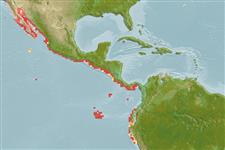Environment: milieu / climate zone / depth range / distribution range
Ecologia
marinhas; estuarina demersal; intervalo de profundidade 0 - 60 m (Ref. 9342). Subtropical; 34°N - 9°S, 118°W - 79°W (Ref. 5222)
Eastern Central Pacific: San Francisco Bay, California, USA to Peru and the Galapagos Islands.
Tamanho / Peso / Idade
Maturity: Lm ? range ? - ? cm
Max length : 150 cm TL macho/indeterminado; (Ref. 5222); peso máx. publicado: 91.0 kg (Ref. 2850)
Descrição suscinta
Chaves de identificação | Morfologia | Morfometria
Espinhos dorsais (total) : 11; Raios dorsais (total) : 15 - 16; Espinhos anais: 3; Raios anais : 10 - 11. Distinguished by the following characteristics: two color patterns, first is brown blotched pattern, grey or greyish green with oblong dark blotches dorsally, forming an irregular maze-like, pale reticulum, second is plain colored pattern is uniform greyish brown, darker fins and edged with white; depth of body contained 2.9-3.1 times in SL; head length 2.6-2.8 times in SL; angular preopercle, with distinct serrate lobe at angle; posterior nostrils notably larger than anterior nostrils (Ref. 89707).
Occurs from mangrove area to over hard bottom of the continental shelf and the slope (Ref. 11035). According to Thomson et al. (1979, Ref. 6852), this species prefers mangrove estuaries. Adults and juveniles occur in shallow water with adults found to depths of 60 m.
Ciclo de vida ou comportamento de acasalamento
Maturidade | Reprodução | Desova | Ovos | Fecundidade | Larvas
Heemstra, P.C. and J.E. Randall, 1993. FAO Species Catalogue. Vol. 16. Groupers of the world (family Serranidae, subfamily Epinephelinae). An annotated and illustrated catalogue of the grouper, rockcod, hind, coral grouper and lyretail species known to date. Rome: FAO. FAO Fish. Synop. 125(16):382 p. (Ref. 5222)
Status na Lista Vermelha da UICN (Ref. 130435: Version 2024-2)
Ameaça para os humanos
Harmless
Uso pelos humanos
Pescarias: pouco comercial; peixe esportivo: sim
Ferramentas
Relatórios especiais
Baixar XML
Fontes da internet
Estimates based on models
Preferred temperature (Ref.
123201): 19.5 - 28.6, mean 24.6 °C (based on 78 cells).
Índice de diversidade filogenética (Ref.
82804): PD
50 = 0.5000 [Uniqueness, from 0.5 = low to 2.0 = high].
Bayesian length-weight: a=0.00933 (0.00426 - 0.02047), b=3.05 (2.88 - 3.22), in cm total length, based on LWR estimates for this Genus-body shape (Ref.
93245).
Nível Trófico (Ref.
69278): 4.5 ±0.8 se; based on size and trophs of closest relatives
Resiliência (Ref.
120179): Baixo, tempo mínimo de duplicação da população 4,5 - 14 anos (Musick et al. 2000 (Ref.
36717)).
Fishing Vulnerability (Ref.
59153): Very high vulnerability (90 of 100).
Climate Vulnerability (Ref.
125649): Very high vulnerability (85 of 100).
Nutrients (Ref.
124155): Calcium = 33.8 [13.6, 69.2] mg/100g; Iron = 0.768 [0.417, 1.456] mg/100g; Protein = 18.9 [17.0, 20.6] %; Omega3 = 0.319 [0.193, 0.557] g/100g; Selenium = 30 [15, 61] μg/100g; VitaminA = 14.1 [4.3, 55.2] μg/100g; Zinc = 0.561 [0.392, 0.838] mg/100g (wet weight);
